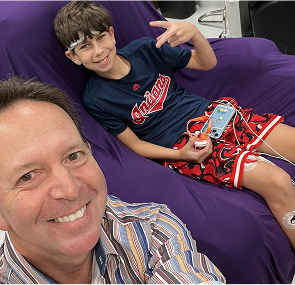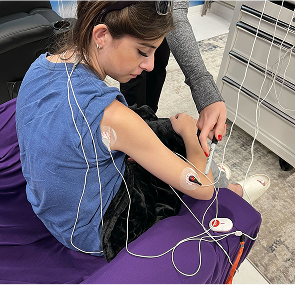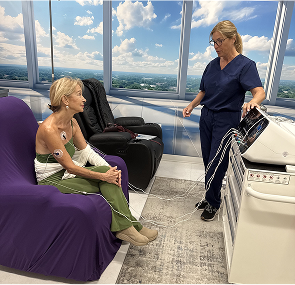Restoring Childhood for CRPS Warriors with Breakthrough Pain Relief of Calmare Therapy

CRPS in children disrupts developmental milestones, identity formation, and social stability. Chronic pain changes behavior, induces school absenteeism, and often leads to mood instability and social withdrawal.
- CRPS leads to missed milestones: Children with Complex Regional Pain Syndrome (CRPS) often miss school trips, sports, and social activities. According to pediatric neurology data, school absence in these cases can exceed 40% of academic days.
- Pain alters identity: Kids experiencing chronic pain may begin to define themselves through their condition. Their social behavior can regress, with increased dependence on caregivers and disinterest in hobbies.
- Peer relationships suffer: Isolation due to pain and missed school weakens friendships. Many kids express feeling “left out” or “forgotten” during recovery.
- Sleep disturbance exacerbates emotional strain: Poor sleep is common in pediatric CRPS, feeding a loop of irritability, fatigue, and increased pain sensitivity.
- Mood changes are frequent: Depression, anxiety, and irritability develop in over 60% of children with CRPS, especially those undiagnosed for more than six months.
Next, discover how Scrambler Therapy offers hope through non-invasive pain relief without medication.
Breakthrough Pediatric Pain Relief: What Is Scrambler Therapy?
What is Scrambler Therapy and how does it help kids with CRPS?
Scrambler Therapy, known by the Calmare® brand, uses electrical stimulation to send non-pain messages to nerves. It retrains the brain’s pain memory without drugs or needles.
- Drug-free and non-invasive: Surface electrodes are used in the treatment, therefore no medication or injections are required.
- FDA-cleared and safe: The FDA has cleared the Calmare device for pain relief, including pediatric use under medical supervision.
- How it works: The Calmare device mimics normal nerve signals and replaces distorted pain signals through the skin, helping “retrain” the nervous system.
- For developing nervous systems: Scrambler Therapy supports pediatric neuroplasticity—helping young brains reshape their response to chronic pain.
- Administered by certified providers: Specialists like Dr. Rick Markson use structured protocols to ensure safety and consistency.
The way that Scrambler Therapy rewires pain at the neural level is described in the next section.
The Science of Pain Relief: How Calmare Therapy Retrains the Nervous System
How does Calmare Therapy affect nerve pain?
Calmare Therapy overrides pain signals at the sensory nerve level by means of neuromodulation. It desensitizes pain receptors and promotes nerve recovery through neuroretraining.
- Neuromodulation in action: Electrical signals are delivered to the skin, targeting the dorsal root ganglion and interfering with abnormal pain signals.
- Neuroplasticity in children: Children’s nervous systems are highly adaptable. Calmare exploits this flexibility for long-lasting nerve reprogramming.
- Targets chronic pain loops: The therapy disrupts persistent pain cycles often embedded in the central nervous system (CNS).
- Reduces sensory distortion: Many CRPS kids report hypersensitivity to touch or temperature. Calmare restores normal sensory feedback.
- No sedatives or invasive procedures: Therapy works externally, avoiding systemic side effects typical of pharmacological treatments.
Continue reading to understand what your child’s pain relief journey might look like—step-by-step.
What to Expect: From Initial Consult to Long-Term Pain Relief
What happens during a pediatric Scrambler Therapy journey?
Children begin with a medical consultation to assess suitability. A treatment plan follows, typically involving 10 sessions over two weeks. Parents track progress through pain-level logs.
- Initial assessment: Dr. Rick Markson performs a full intake, reviewing pain history, behavior, school impact, and functional ability.
- Session structure: Each session lasts 30–45 minutes. Electrode pads are placed on skin near the pain site.
- Monitoring outcomes: Pain levels are recorded before and after each session using age-appropriate scales.
- Parental guidance: Parents receive education on post-treatment care and expectations. Many report a steady reduction in pain over sessions.
- Follow-up care: Optional booster sessions are available if flare-ups occur. Results can last months or even years.
Next, explore why Scrambler Therapy offers a safe, drug-free solution for young pain sufferers.
Pain Relief without Pills: Safe, Drug-Free Healing
Can CRPS in children be treated without medication?
True. Scrambler therapy uses natural nerve signal recalibration to deliver non-opioid, non-pharmacological pain alleviation. There are no systemic side effects or dependency risks.
- Avoids opioid prescriptions: Many conventional treatments involve heavy-duty medications like gabapentin or narcotics. Scrambler bypasses these risks.
- No adverse effects: Unlike anti-seizure drugs or antidepressants, Calmare has no reported systemic side effects.
- Supports holistic recovery: Scrambler works with the body’s natural nerve communication system. It aligns with integrative medicine principles.
- Child-safe and repeatable: Repeated sessions do not increase health risks, and the process is well-tolerated by children.
- Neuro-regulation over suppression: Unlike meds that mask symptoms, Scrambler restores normal nerve function through signal correction.
Now, let’s hear real-life success stories of children who reclaimed their lives after treatment.
Real Stories: Families Reclaiming Joy After Pain Relief
What changes do families see after Calmare Therapy?
Many children return to school, sports, and social life after Scrambler Therapy. Parents report a noticeable return to happiness, self-reliance, and emotional stability.
- Back to school: Kids previously on home instruction return to classrooms full-time. School reintegration is reported in over 70% of treated patients.
- Laughter returns: Parents describe seeing their child smile and play again—often for the first time in months.
- Testimonial - Emma’s Story: A 12-year-old who was bedridden from CRPS started walking without pain after session six. After three weeks, she returned to her soccer team.
- Caregiver experience: Parents report reduced stress, improved family dynamics, and a renewed sense of hope.
- Siblings benefit too: One family noted that their younger son “got his big sister back.”
Next, we spotlight Dr. Rick Markson and why he stands behind Scrambler Therapy.
Professional Insight: Why Dr. Rick Markson Believes Scrambler Therapy for Pain Relief
Why does Dr. Rick Markson use Calmare for pediatric CRPS?
Dr. Markson chooses Scrambler Therapy due to its clinical efficacy, safety profile, and non-invasive design. He is a licensed professional with a wealth of knowledge regarding pediatric pain.
- Advanced certification training: Pediatric care protocols are the emphasis of Dr. Markson's Scrambler Therapy advanced certification.
- Evidence-based outcomes: His clinic reports significant pain reduction in over 85% of treated children.
- Trusted by families: His approach combines clinical excellence with compassionate, child-centered care.
- Prefers neurorestorative over suppressive treatment: He avoids medications unless necessary and promotes nerve recovery.
- Provider credibility: With over two decades in practice, Dr. Markson is known for his creative approaches to treating chronic pain.
Next, we explain why early intervention is critical in preventing long-term damage.
Why Early Pain Relief Matters for a Child’s Future
What are the long-term effects of untreated CRPS in children?
Untreated pain in children can alter brain development, increase the risk of adult chronic conditions, and impair emotional resilience and learning.
- Pain as trauma: Chronic pain causes the brain to develop threat-centered wiring, increasing future anxiety and hypersensitivity.
- Delays in development: Missed school and social interactions lead to academic and social skill deficits.
- Higher risk of mood disorders: Children in chronic pain are 3x more likely to develop depression as adults.
- Neural plasticity window: Early treatment leverages the brain’s adaptability. Delayed care can close this window.
- Protects future health: Effective early pain relief reduces the risk of central sensitization syndromes later in life.
We'll then address the most frequently asked questions by parents regarding Scrambler Therapy.
Pediatric Pain Relief FAQs
Is Scrambler Therapy safe for children?
Yes, it is painless, safe, and well-tolerated by children.
Does it hurt?
No. Most children describe a tingling or buzzing sensation, not pain.
Can my child attend school during treatment?
Yes. Sessions are short and non-fatiguing. Many kids continue school normally.
How long do results last?
Relief can last several months or years. Follow-up sessions are available if needed.
Is it covered by insurance?
Coverage varies. Clinics assist with pre-authorization and offer payment plans when needed.
Now that your questions are answered, let’s explore how to begin the process.
How to Begin: Scheduling Pediatric Scrambler Therapy
How can parents start Scrambler Therapy for their child?
Contact the clinic via phone or online form. Provide basic medical records and schedule a pediatric consultation with a certified provider.
- Call or submit form: Intake teams are trained to guide families through insurance, records, and scheduling.
- Required documentation: Pain history, prior treatment notes, and current diagnoses help build the child’s treatment plan.
- What to expect at the first visit: The child meets with Dr. Markson, receives a baseline pain assessment, and may start therapy that day.
- Parent prep checklist:
- Bring medical summaries
- Write down symptom changes
- Prepare child with simple explanations
Still comparing treatment options? Let’s look at why Scrambler outperforms traditional therapies.
Comparative Overview: Why Scrambler Therapy Outperforms Traditional Pain Relief for Kids
How does Scrambler Therapy compare to TENS, meds, or physical therapy?
Scrambler Therapy offers higher effectiveness, greater comfort, and long-term nerve retraining—without the side effects of medication or compliance issues of PT.
Scrambler stands out by offering comfort, safety, and effectiveness in a single, child-friendly modality.
In the final section, we wrap up with what’s truly at stake: your child’s future.
Hope, Healing & Possibility – A Final Word on Pain Relief for CRPS Kids
Children who receive Calmare Therapy are able to find their way back to school, friendships, fun, and self-assurance. It reopens a future that pain tried to close.
- Restored dreams: Kids return to sports, music, and friendships.
- Family harmony returns: Caregivers report less stress and better home life.
- A pain-free future: Early intervention reduces disabilities during adolescence and adulthood.
- Your next step: If your child suffers from CRPS, early Scrambler Therapy may change their trajectory.
Experiencing Chronic Pain in South Florida?
.jpg)
Discover South Florida Scrambler Therapy is one of the nation’s leading clinics for noninvasive chronic pain relief, offering FDA-cleared Scrambler Therapy® for adults and children. Co-founded by Dr. Rick Markson, one of the few practitioners worldwide to receive advanced certification directly from the therapy’s inventor in Rome, our clinic delivers globally recognized expertise with compassionate, personalized care. If you or a loved one is living with treatment-resistant nerve pain, we invite you to schedule a consultation and explore a life beyond pain.
Recommended Reads:
📘 What is scrambler therapy?
📘 What to Expect During a Scrambler Session
📘 CRPS Pain Relief Without Drugs—Real Patient Stories
📘 Conditions that scrambler therapy can treat
Take the Next Step: Free Consultation at South Florida Scrambler

Every day counts when we suffer from chronic pain. South Florida Scrambler Therapy offers a free initial consultation to determine if Scrambler is right for you. Schedule Today:
- Speak directly with Dr. Rick Markson’s team
- Learn about treatment protocols and insurance
- Complete a customized treatment plan
- Start seeing results within days, not months
📞 Call Now or Visit website: www.southfloridascramblertherapy.com
📍 We serve Palm Beach, Fort Lauderdale, and Miami from our location at 100 NW 100th Ave, Plantation
You Can Follow Us through Our Social Media:
📸Instagram—Day-in-the-life stories from our patients
👍Facebook—Success journeys and community support
You deserves to laugh, and enjoy life without pain. The journey starts here.
Start Your Nerve Pain-Free Journey Today






